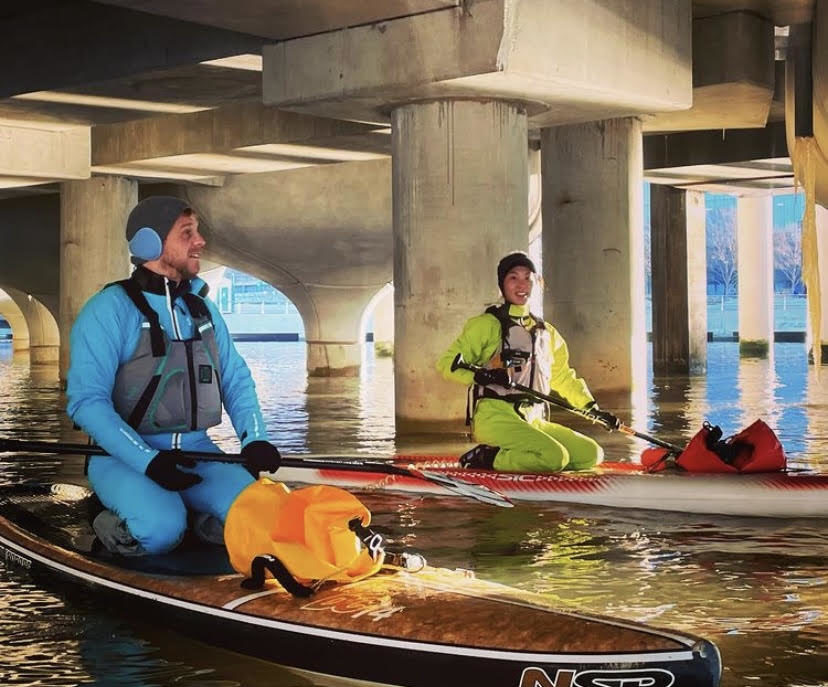How to Paddle Solo in Cool Water

Cool and cold water paddling can be a glorious joy! There’s a lack of traffic, unique angle of the light, and a sense you’re a step closer to a primal reality. Fresh air and blue water creates a wonderful heart-nurturing exercise. Connecting to nature via water can ease our souls. Read about the Blue Mind. However, solo paddling requires awareness, preparation, and respect.
What To Wear After Summer
Read our blog on what to wear.
Know The Water Temperature
Shorter daylight hours and cooler temps mean a higher risk of Hypothermia and Cold Shock. Firstly, use the water temperature to determine what to wear. Then, consult our Weather and Tides page. Paddlers are much more vulnerable to weather than other vessels. Read more about how wind speed affects your paddling. Strong wind makes bigger waves that can lead to capsizing. Wind can turn a 1-hour trip into 2 hours or more.
Create A Float Plan
Those of you who paddle in the Hudson River are surely aware of the tidal currents. Going with them is easy and going against is difficult. Always plan to have favorable currents in both directions. Ride the flood – when water flows north from the ocean – and the ebb – when water retreats south to the ocean.
- At the Battery’s high tide, it’s full-strength flood at Pier 84 Boathouse
- 2.5 hrs after high tide is slack and soon turns south
- 6 hrs after high tide (3.5 hrs after slack) is low tide and full-strength ebb
- 3.5 hrs after low tide is slack and soon turns north
- 6 hrs after low tide (2.5 hrs after slack) is high tide and full-strength flood
In general, the ebb current is longer in duration and stronger in velocity than the flood. The full and new moons make both currents even stronger.
When the ebb meets a strong north wind, the river becomes a field of white-capped waves. Skilled paddlers can have a great time surfing up-current with the wind, then get a fast ride back. SUPers: Here’s a beginner’s video on downwind SUP surfing and a tutorial from Chase Kosterlitz.
Communicate With Other Boats
If you’re paddling without a guide, bring a fully charged VHF marine radio and whistle, signaling device, your phone in a waterproof case, and a charged waterproof headlamp or white light. Use Channel 13 to talk to commercial traffic and Channel 16 for the US Coast Guard. The product protection plan on this West Marine radio is worth it!
Stay Hydrated
For a short paddle, bring a quart of water and easy-to-open energy bars. Be mindful of over hydrating – jumping out to pee is not an option in cold water. Much can be said for a good “relief” zipper on your drysuit.
Know Rescues and Tows
Be able to self-rescue, tow your friends, and be paddle fit. Kayakers: be able to get in and out of your kayak alone using a paddle float, pump out the kayak while wearing a spray skirt, and put on your spray skirt quickly solo. Bring a tow rope, especially if there are paddle boarders with you. We heartily recommend yoga and pilates to bring the extra flexibility in the cold weather.
Paddle With A Partner
It’s best that you join our weekend groups whether you own your boat or not. The après paddle pow-wow’s with a warm mug of coffee, hot chocolate, or matcha with a shared sense of adventure are a reward on their own. But, if you must paddle at a different time, then we heartily recommend going with a prepared buddy. Two is better than one, and three is even better.
For Soloists
If you must go solo, use top quality gear and your own sea-worthy vessel. Go when there’s low wind and stick to short distances. Prepare your float plan ahead and be confident that you can execute a self-rescue. If you can’t do this, never go alone.
